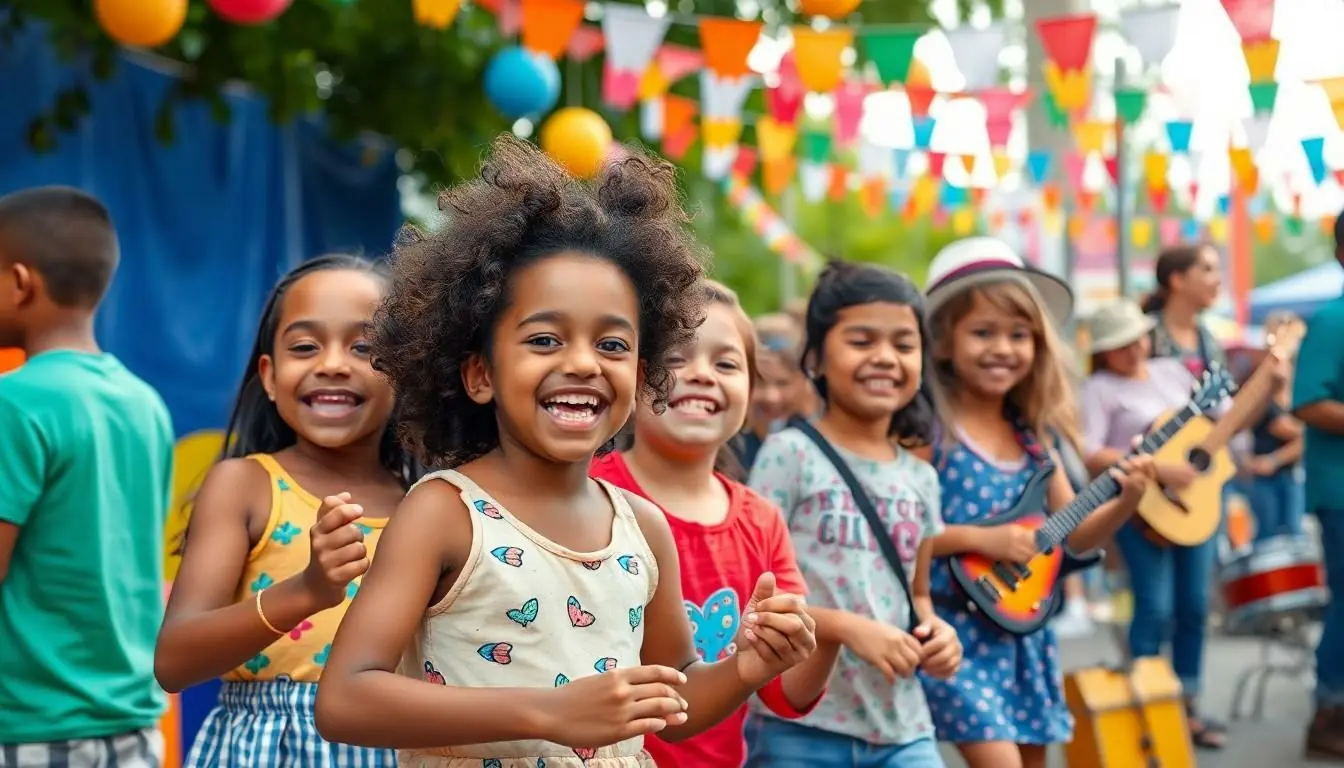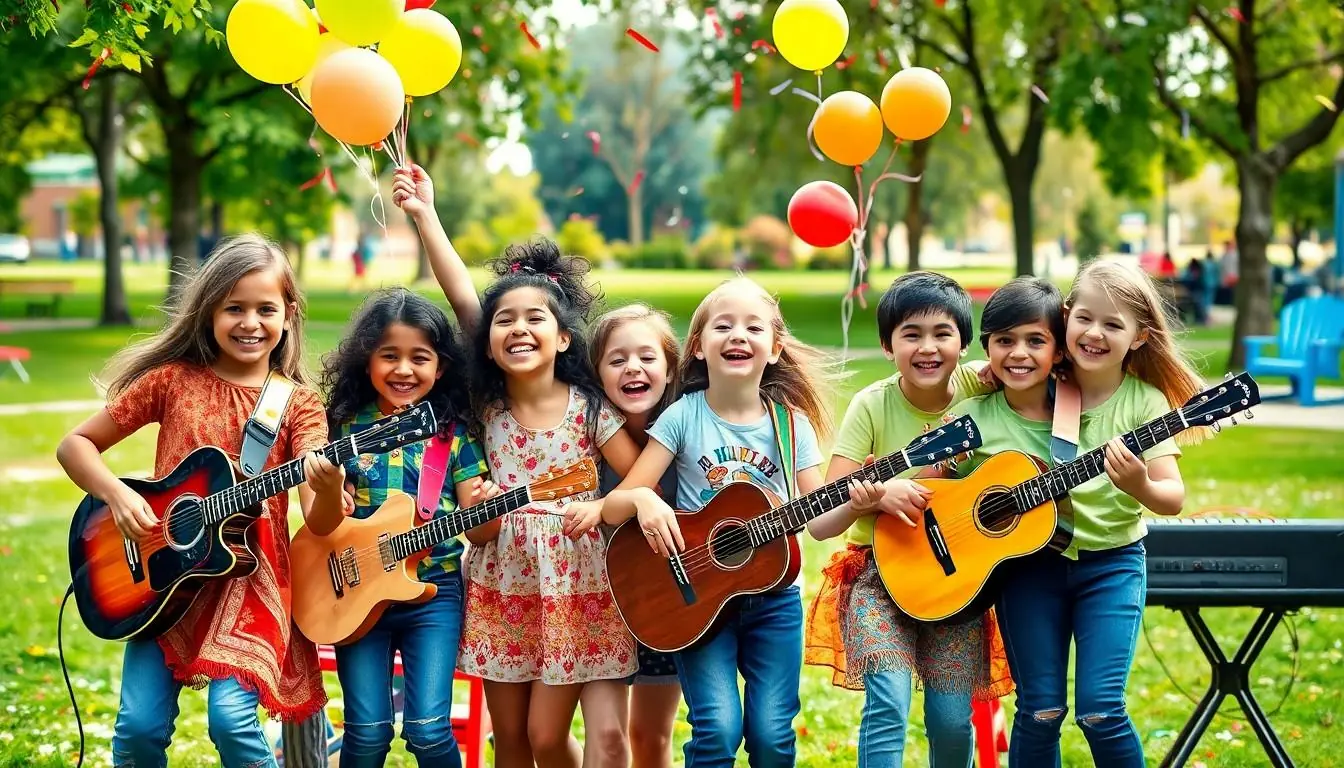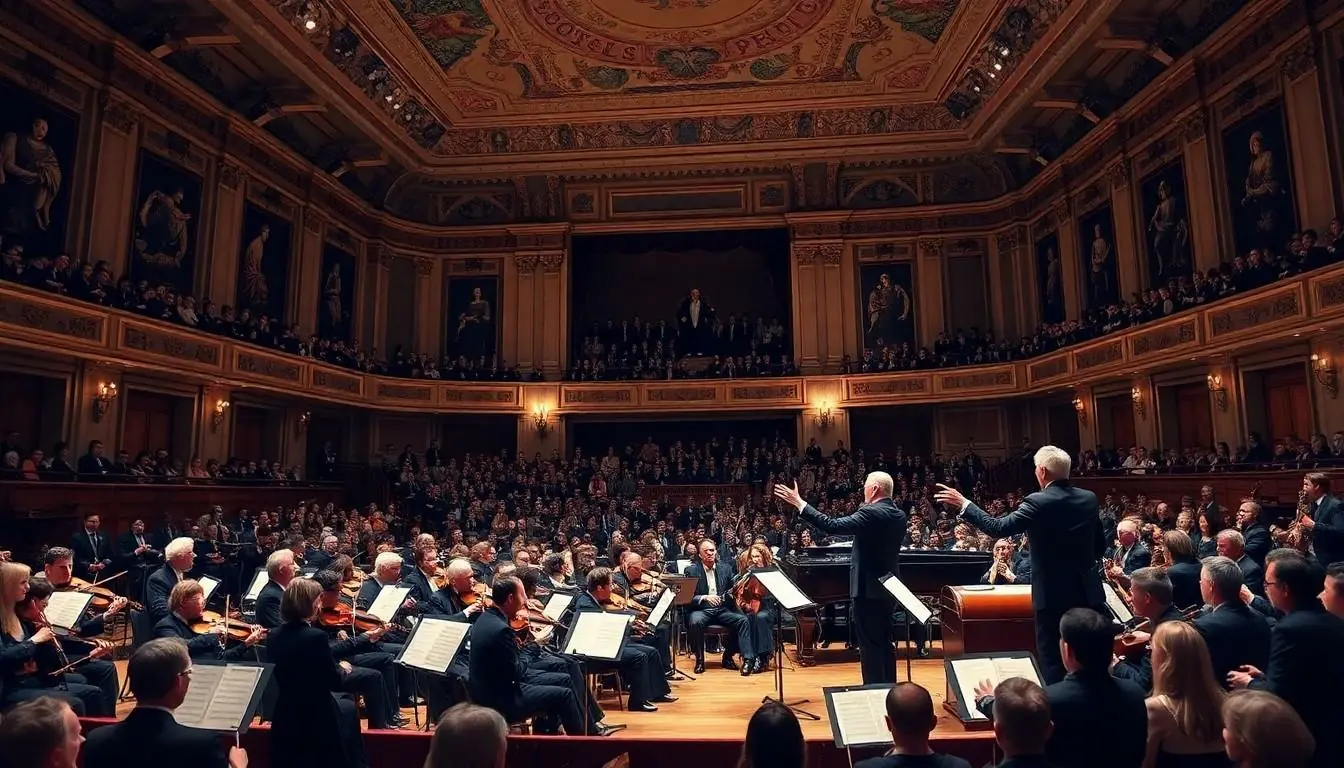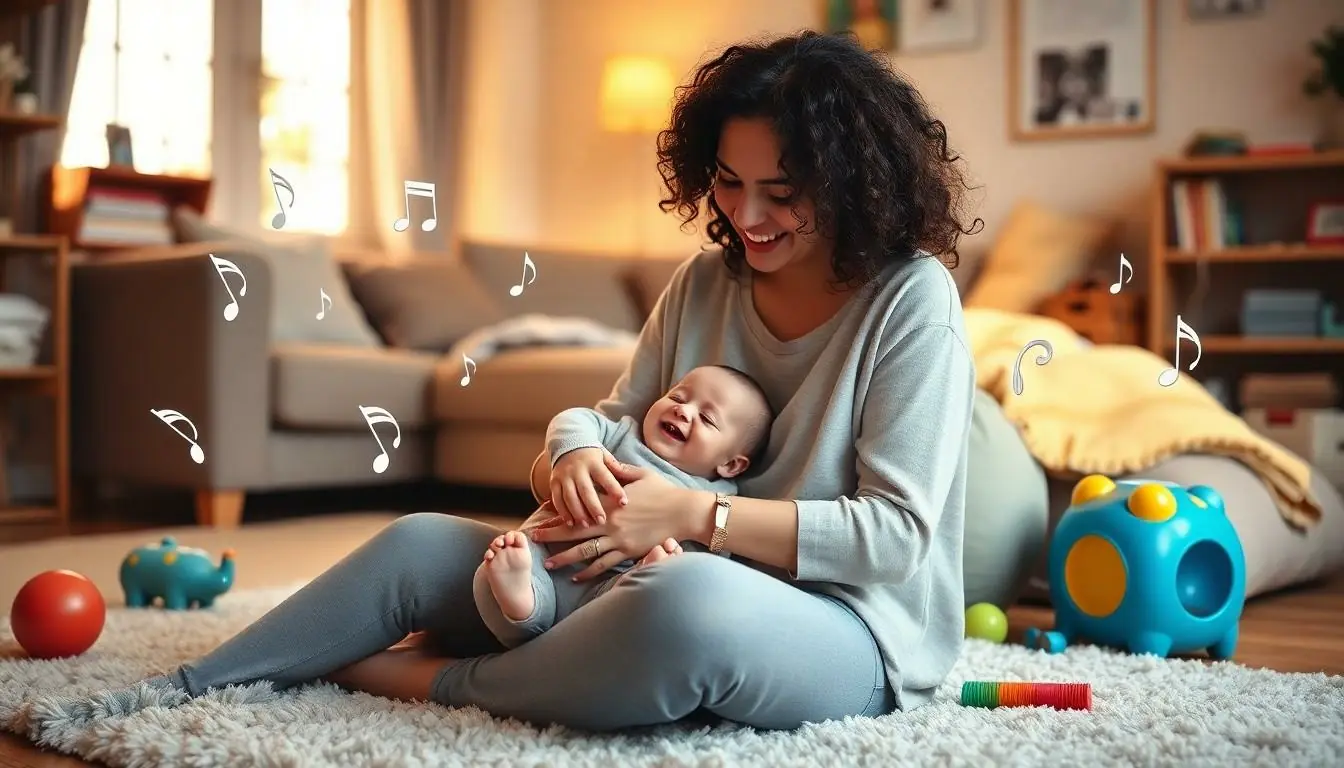Pop music for kids isn’t just about catchy tunes and danceable beats; it’s a magical gateway to creativity and expression. Imagine little ones belting out lyrics with the same passion as their favorite stars, all while honing their social skills and boosting their confidence. It’s like giving them a backstage pass to the world of music, where imagination knows no bounds.
Table of Contents
ToggleOverview of Pop Music for Kids
Pop music serves as a vibrant gateway for children to explore creativity. This genre captures their attention with catchy melodies and relatable lyrics. Engaging with pop music allows kids to express their feelings and experiences authentically.
The genre also fosters social interactions. Kids often share favorite songs, creating bonds with peers while discussing artists and lyrics. These connections can enhance communication skills, important for personal development.
Pop music introduces diverse themes that resonate with childhood experiences. From friendship to empowerment, lyrics reflect the complex world children navigate. Exposure to these messages can contribute positively to emotional intelligence.
Various artists target younger audiences specifically within pop music. For example, performers like Taylor Swift and Justin Bieber release tunes appealing to kids, combining fun with meaningful messages. Songs from movie soundtracks, such as those from Disney, further enhance this genre’s popularity among children.
Industry statistics indicate a growing market for children’s pop music, with revenue reaching over $1 billion in recent years. The rise of platforms like Spotify and YouTube allows easy access to kid-friendly playlists, making music readily available.
Overall, pop music for kids not only entertains but educates. Its rhythmic tunes and relatable themes cultivate an engaging environment for children, promoting both personal growth and social engagement.
Benefits of Pop Music for Kids

Pop music provides numerous advantages for children, enhancing their development in various aspects. Engaging with this genre allows for an improved quality of life.
Enhancing Creativity
Pop music stimulates children’s imagination through catchy melodies and relatable lyrics. Listening to diverse songs fosters an environment where kids feel free to express their feelings. They explore new ideas and themes while appreciating the art of music. Participating in sing-alongs encourages spontaneous creativity. Writing their own lyrics or creating dances to favorite tunes serves as a valuable outlet. Young listeners also gain inspiration from vibrant visuals and storytelling, allowing them to expand their creative horizons. By interacting with music, kids learn to think outside the box and develop unique perspectives.
Improving Social Skills
Pop music significantly enhances children’s social skills by encouraging interaction and collaboration. Kids bond over shared interests in artists and songs, promoting discussions and teamwork. Group activities like dance parties or singing competitions create a sense of community. Such experiences help children build friendships and improve their communication skills. Engaging with pop music also teaches important lessons about empathy and emotional awareness, as lyrics often address relatable experiences. Exposure to diverse musical themes encourages understanding and appreciation of different perspectives, fostering a more inclusive worldview. Overall, pop music plays a central role in social development for children.
Popular Artists in Kids’ Pop Music
Kids’ pop music features a range of artists appealing to younger audiences. These musicians create catchy tunes and relatable lyrics that foster connection among children.
Current Chart-Toppers
Current chart-toppers include artists like Olivia Rodrigo and Katy Perry. Rodrigo’s fresh sound resonates with kids, encouraging self-expression through her relatable storytelling. Perry delivers upbeat and vibrant tracks that inspire fun and creativity. Other notable names are JoJo Siwa and Lil Nas X, both of whom have captured the attention of young listeners with their engaging beats and vibrant visuals. Recent hits from these artists often feature positive messages, enhancing their appeal to caregivers and parents.
Timeless Classics
Timeless classics in kids’ pop music shape the genre’s foundation. Artists like Britney Spears and the Backstreet Boys remain beloved by younger generations. Their catchy tunes and memorable melodies continue to influence today’s artists. Disney soundtracks also play a significant role, with films like “The Lion King” and “Moana” offering songs that capture children’s imaginations. These classics provide a nostalgic experience for parents while introducing children to the joy of music. Strong connections through familiar lyrics foster lasting memories, making these songs a staple in kids’ pop culture.
Themes and Messages in Kids’ Pop Music
Themes and messages in kids’ pop music often revolve around friendship, resilience, and self-acceptance. Pop songs resonate through relatable lyrics that echo children’s daily experiences. Positive storytelling encourages young listeners to embrace their individuality and take pride in their unique qualities.
Friendship is a common theme, with many songs celebrating connections among peers. Artists like Olivia Rodrigo and Katy Perry create anthems that underscore the importance of loyalty and support. Such messages foster community and companionship, highlighting social dynamics characteristic of childhood.
Resilience is another prevalent theme in kids’ pop music. Through catchy melodies, artists communicate messages of perseverance in the face of challenges. Songs with uplifting lyrics empower children to overcome obstacles, inspiring them to stay determined during difficult times.
Self-acceptance also plays a crucial role in the genre. Many pop songs feature empowering narratives that promote body positivity and self-love. These messages encourage children to appreciate themselves for who they are, fostering a sense of confidence.
Emotionally resonant lyrics often bridge connections between kids and their favorite artists. Songs from Disney soundtracks, such as those from “Frozen” and “Moana,” resonate deeply, bringing themes of courage and adventure to life. Such familiarity helps kids process their feelings while engaging with beloved characters.
Incorporating diverse themes enriches the listening experience for children. Notable artists prioritize messages that reflect inclusivity and understanding. It’s this blend of catchy tunes with meaningful content that elevates pop music, making it a powerful tool for emotional intelligence development.
Trends in Kids’ Pop Music
Recent trends in kids’ pop music showcase the evolution of themes and sounds that resonate with young audiences. Catchy hooks paired with relatable lyrics engage children, making songs both enjoyable and meaningful. Incorporating positive messages becomes increasingly essential, as artists focus on empowerment and self-acceptance.
Emerging artists like Olivia Rodrigo and K-Pop groups such as BTS also capture children’s attention. These artists blend catchy melodies with narratives that reflect kids’ experiences, fostering deeper connections. Social media platforms amplify this connection, allowing kids to share their favorite songs and artists widely.
Quirky visuals in music videos enhance engagement, making songs even more memorable. Bright colors, fun dances, and animated characters draw children in, creating an inviting atmosphere. Consequently, animated films and series from Disney and other studios continue to play pivotal roles in shaping trends. Iconic soundtracks from films like “Frozen” and “Encanto” serve as gateways to the pop music genre for many kids.
Furthermore, collaborations between popular artists and child-friendly brands promote music exposure. These partnerships create opportunities for interactive experiences that align with children’s interests, reinforcing the appeal of relevant themes.
Diversity in pop music contributes significantly to its evolution, showcasing a multitude of genres. From hip-hop to electronic influences, incorporating various styles prepares kids for musical exploration. Age-appropriate lyrics allow songs to remain relatable while addressing issues like friendship and resilience, which mirror children’s everyday lives.
Overall, the landscape of kids’ pop music thrives through a balance of fun, connection, and positive messaging, ensuring its continued relevance in children’s lives.
Pop music for kids is more than just catchy tunes; it’s a vital part of their growth and development. Through engaging lyrics and vibrant melodies, children find avenues for creativity and self-expression. As they connect with the music and each other, they build social skills and emotional intelligence.
The genre’s ability to resonate with young listeners helps them navigate their feelings and experiences. With artists continually evolving their sound and themes, pop music remains a powerful force in shaping childhood memories. It’s a joyful journey that not only entertains but also nurtures a sense of community and belonging among kids.




